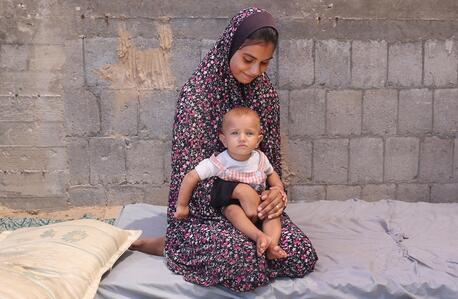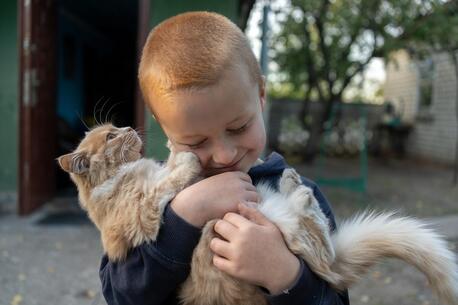
Growing Up in Conflict in Ukraine: Lessons No Child Should Learn
For eight years, hundreds of thousands of children in eastern Ukraine have been longing for peace.
On Feb. 10, 2022, 16-year-old Nastia led a visitor on a tour of her first school, just across the road from her family's home in the village of Pavlopil, Volnovakha, Donetsk oblast, eastern Ukraine. The building has been closed since it was damaged by heavy fighting in 2014.
Her former classroom sat empty; she hardly recognized the floral wallpaper punctured with shell fragments. There were jagged holes in the roof and a burning smell in the air. Shelling, mines and missiles have become part of daily life for children growing up along the contact line.
Shelling, mines and missiles have been a part of daily life for children growing up along the contact line since 2014
"I attended this school from the first to the second grade," Nastia said. "Since then, I often dream in my heart that I wish that time back. There were many children and teachers. It was fun here. We played, read and ran here."
After her school closed, Nastia switched to another school farther from home. She said she would like to join a dance club or an art class or a music school, but that it was not possible in her village, which was still under shelling. So she was spending her free time at home, drawing, playing with her younger sister and helping her mother around the house.
"I don't want the fighting to repeat, because it's extremely scary," said Nastia. "You don't know where the shell will hit, what will happen next. You have to ask yourself — how would I cope with it? How can you help yourself to forget about it? I wish it was like before when everything was safe."
"You don't know where the shell will hit, what will happen next." — Nastia, 16
More than 750 schools and kindergartens were damaged in the eight years since violence in the region first began, disrupting access to education for thousands of children on both sides of the contact line. Parents concerned for their children's safety would keep them home from school even when classes were in session.
To help children get back to learning, UNICEF has been supporting repairs to damaged schools. These emergency repairs, which included improvements to water and sanitation facilities, benefited 7,400 students — boys and girls — in 2021. Another 8,200 children benefited from teacher trainings provided by UNICEF and its partners. UNICEF has also been providing psychosocial support for children traumatized by the chronic insecurity and distributes vital education supplies such as educational kits, furniture sets and sports equipment — all efforts that UNICEF is now preparing to scale up and expand to other parts of the country as conflict escalates.
UNICEF is on the ground delivering psychosocial support, education and other critical services to children in Ukraine
Most of all, the children of Ukraine need to learn what it feels like to grow up in safety, without fear. “The past eight years of conflict have inflicted profound and lasting damage to children on both sides of the line of contact," UNICEF Executive Director Catherine Russell said in a statement on February 24. "The children of Ukraine need peace, desperately, now."
UNICEF remains on the ground in Ukraine, working on both sides of the contact line to support education and other vital services, including health care and nutrition. Help UNICEF reach the most vulnerable. Donate today.
Top photo: On Feb. 10, 2022 in eastern Ukraine, 16-year-old Nastia stands in a classroom of the empty school where she was once a student. The school was badly damaged by heavy shelling in 2014. © UNICEF/UN0597396/Filippov. Video edited by Tong Su for UNICEF USA.
For eight years, hundreds of thousands of children in eastern Ukraine have been longing for peace. [VIDEO]
HOW TO HELP
There are many ways to make a difference
War, famine, poverty, natural disasters — threats to the world's children keep coming. But UNICEF won't stop working to keep children healthy and safe.
UNICEF works in over 190 countries and territories — more places than any other children's organization. UNICEF has the world's largest humanitarian warehouse and, when disaster strikes, can get supplies almost anywhere within 72 hours. Constantly innovating, always advocating for a better world for children, UNICEF works to ensure that every child can grow up healthy, educated, protected and respected.
Would you like to help give all children the opportunity to reach their full potential? There are many ways to get involved.





